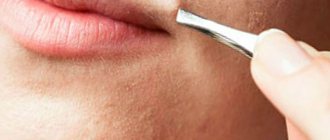Contact lenses are an excellent alternative to corrective glasses. There are many reasons for this. They are invisible when worn, comfortable, and provide clear and contrasting vision.
However, some people worry that the optical product may get lost in the eye. Of course, such a problem, although quite rare, is still not excluded. How to avoid unpleasant consequences and what to do if the lens is lost?
Contact correction means are a purely individual thing, which should be selected by a qualified specialist taking into account your individual parameters. Patients often ask ophthalmologists the question: can it get lost in the eye? What to do in such a situation, do I need to buy additional funds? As a rule, if the selection was carried out in a hospital, clinic or private ophthalmology office, then the optical products prescribed by a specialist are not felt when worn and do not cause discomfort. When put on, they are located at the level of the pupil and should not move when blinking and other movements of the visual organs. However, due to the fact that the eyeball is spherical in shape, the possibility that the product may move behind the eyelid cannot be completely ruled out. Why is this happening?
Common Causes
The main problem that some users face today is incorrect selection. This often happens to those who neglect the recommendations of the attending physician or completely refuse to visit him. If the base curvature was chosen incorrectly, the product will not fit tightly, which can lead to its further loss. In addition, how comfortable the correction device will be located largely depends on the material used in production.
For example, hydrogel optical products, characterized by a high moisture content, may not immediately take the required position and are more at risk of loss than others. In this regard, silicone hydrogel lenses for the eyes are considered more practical, which, according to ophthalmologists and users themselves, are much easier to handle and usually do not cause such problems. Another challenge that beginners may encounter is maintaining proper donning technique. The fact is that when you bring the correction agent to the organs of vision, a protective reflex may be triggered, consisting of rapid blinking. Because of this, it may not have time to take the required position on the cornea and, as a result, get lost.
What to do if the lens is lost in the eye?
If before going to bed, having decided to remove optical products, you find that you cannot find one of them, you should make sure that it is really missing. Contact optics are thin and transparent, and therefore are not always noticeable.
If, after correctly performing these manipulations, you think that the lens is lost, then you should drip your eyes with special moisturizing drops, which you can order in our online contact lens store. Repeated instillation will allow you to remove the product from under the eyelid. The fact is that the liquid will allow it to “float” out, after which it will not be difficult to detect it. According to contactologists, it is much more convenient to ask another person to do this. If it is not possible to remove the product in this way, you should consult an ophthalmologist. Moreover, the sooner you do this, the better for your health, since a foreign body can lead to the development of conjunctivitis - inflammation of the mucous membrane.
What to do if the lens goes under the eyelid
For many years now, due to poor vision, namely “-3.5”, I have been using soft contact lenses. Very comfortably. I like. Almost everything. Except one. From time to time, when removing lenses from the eyes (and I have heard that for some, even when putting them on), it happens that the lens goes under the eyelid. This is very unpleasant, and most importantly, it can frighten. I remember my first experience when I simply “lost” the lens when removing it and couldn’t figure out where it had gone, but in the end it turned out that it simply went under the upper eyelid. To say that I was scared is to say nothing. I took it out for several hours. During this time I became all nervous and was already getting ready to go to the hospital to see an ophthalmologist. The only thing that stopped me was that it was almost night outside, and we had to go to the other end of the city.
Still, I took it out myself. This was back in 2008. The next time such a problem happened to me was in 2009. And I took it out faster, but I was no less nervous, despite the first successful experience of “losing” lenses.
And yesterday, already knowing that this could happen, I again found myself in this difficult situation. And when it was all over, I thought, this probably happens not only to me. These are the conclusions I drew after going through this all three times. What do we have to do:
- Calm down. Move away from the mirror and make, for example, some tea. Or something else distracting and relaxing. It won't get any worse, but peace of mind will come in handy. No need to rub your eye, no need to try to move the lens under your eyelid closer to the exit. Experience shows that this does not help. The eyelid will still lift the lens higher and higher.
- Remember that nature is wise and the eye is designed to clean itself. Otherwise, we would all be walking around blind a long time ago, if all the crap that catches our eye remained there. And understand that sooner or later the lens will be removed, it’s a foregone conclusion)))
- When you calm down and understand that you can try to remove the lens that has “run away” under the eyelid, proceed)) First of all, add light if it is not enough. Because light is the main assistant here. I bring a light bulb on a clothespin into the hallway to the large mirror and hang it next to it. Next, raise your head as high as possible so that your chin is almost horizontal. Ophthalmologists recommend placing a mirror on the table and looking from above. The effect is the same, but much darker and less visible, in my opinion. Although it is fashionable to try it this way. Whichever is more convenient for you.
- Now pull your eyelid up and carefully look where it (your lens) is. If possible, then look down with the eye with the lens, and with the other eye, inspect the eyelid that “stole” the lens. I can’t do that))) I look with both eyes at once, although this is less productive. If you don’t see it (the lens), put a drop of lens solution or any eye drops that moisturize the pupil on your eye. And blink often. This will move the lens lower. They say that by blinking for a long time (up to 2-3 minutes), they can thus “push” the lens out from under the eyelid. But I find it hard to believe that I can blink continuously for 2 minutes, let alone three)). After instillation, pull back the eyelid again and try to look for the “lost” one. Inspect carefully. Must see.
- And then it’s a matter of technology. Take the lens tweezers and remove the lens from the eyelid or, if it is far enough away, release the eyelid, blink a little and look again. Most likely it will become closer to the edge of the eyelid, and it can be removed.
- If it didn't work out. We begin to read point No. 1 and go all the way again.
p>In principle, there is nothing complicated. The main thing is to really calm down and understand that the connective tissue will not allow the lens to “fall” behind the main apple, and it will not go anywhere for a century. And if so, it is doomed to be taken out.
Sincerely yours Lyudmila Shalafan, 06.28.2011
When using materials, please put a link to my website Website of the Modern Woman © 2008-2012 site opened 2008 November 17
Is it possible to lose a contact lens in your eye?
Why can a contact lens get lost in the eye?
Contact lenses are designed in such a way that when put on, they lie exactly in the middle of the eyeball, just at the level of the pupil. When a person moves his eyes, closes his eyelids, blinks and makes other movements, the lenses stay tightly in place and provide good vision in any situation, so they are more convenient to use than glasses that can fall, break, or move. When contact lenses are used correctly, they cannot get lost in the eye.
But since the eyeball has a spherical shape, it is possible that the lens will move behind the eyelid. This can happen if you “help” her to do this, for example, by rubbing her eyes hard or by swimming with her eyes open underwater. For example, if you put on the lens incorrectly - on the wrong side, then the person will experience discomfort, the eye will begin to itch and water. Not everyone immediately understands what’s wrong, and sometimes they start rubbing their eyes, in which case the lens may move under the eyelid or behind the eyelashes.
The smallest speck of dust or scratch on a thin material can also cause discomfort.
Another reason for losing a lens in the eye is an incorrectly selected diameter. The choice should be made by a specialist who will make all the necessary measurements, including the radius of curvature and diameter. Correctly selected lenses immediately fit correctly on the eyeball, and cups that are too large or small move when blinking or moving the eyes.
What to do if you lose a lens in your eye?
If you decide to remove the lens and find that you can't find it in your eye, first make sure that it has actually moved out of place. The lenses are transparent and thin, they are almost invisible on the eyeball and are difficult to see. Usually they are removed with a slight movement of two fingers, directed from the edges to the center - if as a result the cup does not separate, it seems that the lens simply does not exist. In fact, sometimes the lens is difficult to remove if it is not sufficiently moistened. This method of vision correction dries the eyes, so ophthalmologists advise using special drops. Apply eye drops and try to remove the lens again.
Your vision will also help you make sure that the lens is lost: if it has deteriorated sharply, it means that it does not cover the pupil.
If you are convinced that the lens is really not in place, try to remove it from under the eyelid using repeated drops - the liquid will help the edge “float” out, after which you need to grab it and pull it out. It’s more convenient to do this not on your own, but to ask another person.
If you cannot remove the lens, contact your ophthalmologist. It is advisable to do this as quickly as possible; the longer the lens remains in the eye, the more likely it is to develop conjunctivitis.
I can't find the lens in my eye
Chronic diseases: not specified
Hello, Doctor. Help me please. I started to remove the lenses (before that I had removed them once during the entire period of wearing these two-week lenses) and it came off normally from my right eye, but there was no lens in my left eye. How is this possible. After all, it couldn’t fall out, since it had never fallen out before. Yes, I would have noticed, and if it fell out, then my eye would begin to see worse, but everything was fine. And if she were somewhere behind my eyelid, I would feel it. But there is no discomfort. Please tell me, COULD SHE, NO MATTER IT SOUND, STICK TO THE EYE TO THE PUPIL (WHERE IS IT DRESSED) SO THAT IT IS NOT VISIBLE TO AN ORDINARY PERSON AND NOT TO A DOCTOR? Maybe she has dissolved. Help me please. What to do! Very worried!
Tags: how to find a lens in the eye, can a lens get lost in the eye
The lens went under my eyelid. I can’t figure out if the lens went under my eyelid or if it fell off? To me.
I can’t get the lens out from under my eyelid. What should I do if the lens goes under my eyelid and is not visible?
Lens stuck Doctor. Help me please! I swam in the sea wearing lenses after that.
Is the lens under the eyelid? I have the following problem: I took off the lens, it didn’t come off well, and so did I.
The sharpness disappears. I am 16 years old. A month ago I went to an ophthalmologist. The reason was.
Cloudiness in the eye after the lens I wear night lenses. Everything was fine, but somewhere from the end.
My eyes swell from the lenses. My vision is 2.0 in each eye. I wore glasses for 2 years, but...
Allergy to contact lenses. I've been wearing contact lenses for 6 years. Then an eye infection started, which was treated.
Swollen eyes after losing a lens. Please advise what can be done to relieve the swelling of the eye. Yesterday.
Problems with lens solution I have poor vision, -2 in one eye, -1.5 in the other.
Red eyes after removing lenses I just recently started wearing lenses even after removal.
My eye hurts and waters. My eye hurts and waters; it hurts in the light. When the wind does too.
Red blood vessels in the eyes I wear 3-month lenses, for astegmatists, I recently got sick.
One eye sees dimly in the lenses. The situation is as follows. A couple of days ago I decided to buy it.
How to put on lenses correctly Today my daughter got lenses (she is 16 years old). They said it was possible.
1 answer
Don't forget to rate doctors' answers and help us improve them by asking additional questions about the topic of this question. Also, don’t forget to thank your doctors.
Hello! Of course, she couldn’t dissolve. Close one eye and the other and determine how the left eye sees: good (as in a lens) or bad (as without a lens). There are two options: 1) the lens is stuck to the cornea (“where it goes”). In this case, the eye will see well. The average person may not see it due to inexperience; it will be difficult for you to see if you have removed the lens on the other eye. 2) if the eye sees poorly, then either it was lost (for example, when you rubbed your eye hard), or it has shifted and is under the eyelid. Do not try to look for a lens in your eye yourself, so as not to injure your eye. Contact an ophthalmologist; when examined with a biomicroscope, he will give you a definite answer and appropriate recommendations.
7 reasons why your outfit looks cheap
It's easy to create an expensive fashionable look. To do this, you don’t need to spend fabulous amounts of money, because simple style rules will help you avoid common mistakes that simplify your outfit. A cheap item doesn't have to look cheap. So take a pen and write down little fashion secrets that will help you always look like a million dollars.
4 easy ways to tie a scarf beautifully
How to tie a scarf beautifully?
Spring-summer 2020 season – what will be fashionable
7 Budget-Friendly Ways to Create an Expensive Fashion Look
beauty
The most fashionable hairstyles of 2020
The approach of the warm season awakens the desire to “play” with your hair and try to somehow style your strands in a new way. Fashion designers come to our aid, presenting the most current fashionable hairstyles of the coming season in their new collections.
The sexiest places for tattoos (47 photos)
5 Brand New Ways to Draw Arrows
How to draw perfect arrows?
How to highlight the beauty of your face with your hairstyle
Trends
Getting your clothes and shoes in order for spring
It's time to go through your closet and take out your favorite spring dresses, jeans and shoes. Our selection of life hacks will help you quickly prepare clothes, shoes and accessories for spring.
Is the Internet making us dumber?
Cookies! 5 original recipes for lazy housewives
Time to Refresh: 6 Homemade Frozen Desserts
20 Easy Summer Snacks in 10 Minutes
Health
8 reasons to add cinnamon to your food
Cinnamon is a popular spice that we often add to apple pie, coffee, or hot chocolate. It gives dishes a unique aroma and spicy taste.
14 breakfasts for those who want to lose weight in 2 weeks
How to start exercising at home
9 Pilates exercises for a flat stomach
5 ways to speed up your metabolism in the morning
Relationship
5 types of female orgasm
Orgasm is a complex psychophysiological process, the basis of which is located in the brain. Stimulation of specific pleasure zones of the brain leads to the manifestation of orgasm. The inclusion of these zones occurs under the influence of impulses coming from the woman’s genital organs.
The simplest Kama Sutra poses that can be repeated
5 sex positions for instant orgasm
Sex positions that all men love
What to do after unprotected sex?
Rest
18 of the rarest cat breeds from around the world
There is hardly a person who sincerely admits that he does not like cats. We have made a selection of the rarest breeds from all over the world, many of which you may have never heard of. So, let's begin.
DIY flower box
TOP 14 most dangerous pets
European cities that travelers underestimate
The most dangerous foods for dogs
Career
Simple methods for taking notes in lectures
At the university they teach you anything, but not how to take notes correctly and retain the necessary educational material on paper and in your head. Simple and effective note-taking methods will help correct this.
10 Habits of Successful People
10 rules to help you find your dream job
What you need to know about contact lenses
Health What can your eyes tell you?
We often hear that you can tell a lot about a person’s character and mood by looking at their eyes. But the eyes are not.
Health 5 vitamins that can be obtained from ordinary foods
Experts say the best way to get your daily amount of vitamins and minerals is to consume them.
Health Medical tests you must undergo
It is easier to prevent a disease than to treat it. Therefore, despite the high pace of life and constant employment, everyone is modern.
Health How to choose and wear contact lenses correctly?
Is this your first time using contact lenses? Don't know how to choose and wear them? Or you already use lenses, but don't.
Contact lenses are designed in such a way that when put on, they lie exactly in the middle of the eyeball, just at the level of the pupil. When a person moves his eyes, closes his eyelids, blinks and makes other movements, the lenses stay tightly in place and provide good vision in any situation, so they are more convenient to use than glasses that can fall, break, or move. When contact lenses are used correctly, they cannot get lost.
The smallest speck of dust or scratch on a thin material can also cause discomfort.
Another reason for lens loss is an incorrectly selected diameter. The choice should be made by a specialist who will make all the necessary measurements, including the radius of curvature and diameter. Correctly selected lenses immediately fit correctly on the eyeball, and cups that are too large or small move when blinking or moving the eyes.
Can a contact lens get stuck in the eye?
Can a contact lens get lost in the eye? The lens certainly cannot disappear without leaving a trace in the eye. It can, for example, roll under the upper eyelid. This is not critical, and there is no need to panic in this situation. Under no circumstances rub your eye while trying to move it. The eyelid will still “lift” the lens upward. You need to calm down and do the following:
- Wash your hands thoroughly. Remember that all actions with the eyes should be performed only with perfectly washed hands.
- Sit in front of a mirror, provide good lighting, raise your chin almost horizontally and pull down your upper eyelid. If the lens is still not visible, then apply moisturizing drops and blink for 2-3 minutes. This will help the lens slide down, and you will definitely see it.
- Try to carefully grab the lens with tweezers and pull it out of the eye. And don’t worry that it will roll over the protein – the connective tissue simply won’t allow this to happen.
If you still do not find the lens after all these steps, perhaps it simply fell out of your eye, for example, while taking a shower. Just in case, you can go to the ophthalmologist to make sure that it is not in the eye.
What to do if the lens breaks on your eye? Yes, it also happens that a thin lens breaks right in front of the eye. This usually happens if the eye is too dry or the size is incorrectly selected - there can be various reasons. When ruptured, particles of polymer material remain on the cornea. They can injure it or move under the eyelid. In this case, you should drop a large number of moisturizing drops into the eye, carefully remove the pieces and blink well so that the particles come out from under the eyelid with the liquid. Then carefully remove the residue with a cotton swab soaked in a moisturizing solution. But if you are not completely sure that all the remains have been removed, it is still better to visit an ophthalmologist.
The lens is stuck to the cornea, what should I do? If the lens suddenly stops moving and sticks to the eye, immediately apply a lubricating or moisturizing solution recommended by your doctor. If this does not help, then immediately contact a specialist.
As you can see, when wearing lenses, unpleasant situations may arise related to their removal. There is no need to panic; it is important to try to remove the rolled or torn lens in time; it should not remain there for a long period of time. And always remember the rules of hygiene when you remove or put on lenses - many problems arise precisely because of non-compliance with these simple rules. Only you yourself are responsible for the health of your eyes!
What to do if you lose a lens in your eye?
If you decide to remove the lens and find that you can't find it in your eye, first make sure that it has actually moved out of place. The lenses are transparent and thin, they are almost invisible on the eyeball and are difficult to see. Usually they are removed with a slight movement of two fingers, directed from the edges to the center - if as a result the cup does not separate, it seems that the lens simply does not exist. In fact, sometimes the lens is difficult to remove if it is not sufficiently moistened. This method of vision correction dries the eyes, so ophthalmologists advise using special drops. Apply eye drops and try to remove the lens again.
Your vision will also help you make sure that the lens is lost: if it has deteriorated sharply, it means that it does not cover the pupil.
If you are convinced that the lens is really not in place, try to remove it from under the eyelid using repeated drops - the liquid will help the edge “float” out, after which you need to grab it and pull it out. It’s more convenient to do this not on your own, but to ask another person.
If you cannot remove the lens, contact your ophthalmologist. It is advisable to do this as quickly as possible; the longer the lens remains in the eye, the more likely it is to develop conjunctivitis.
Ophthalmologists and contact specialists constantly answer all sorts of questions related to wearing contact lenses. In this article we will present the most popular questions and answers to them.
— Is it possible to sleep in contact lenses? - Indeed, you can sleep in some contact lenses, but not all are designed for this.
Depending on their oxygen permeability, contact lenses are divided into three categories: day wear, which must be removed at night, flexible wear, which can be left on for one or two nights, and extended wear, which can be worn for up to 30 nights in a row (for example, and Pure Vision). But no matter what lenses you wear, there is still a chance of developing microbial keratitis if you do not remove them at night. Therefore, you should wear flexible or extended-wear contact lenses with extreme caution, and regularly see your ophthalmologist.
— Why do you need to replace contact lenses on time if everything feels good? — Everything may feel fine, but timely replacement of contact lenses is the key to eye comfort and health.
After the expiration date, deposits from tears, hands, and the environment begin to accumulate on the lenses. They can damage the surface of the lens, cause eye irritation, visual disturbances, and lead to eye health problems.
— What to do if you lost one contact lens? Can I buy contact lenses individually? “That’s why contact lenses are sold in packages.” Firstly
, the contact lens may get lost.
Secondly
, you don’t have to rewear your lenses when their wearing period ends and you haven’t bought a new pair yet.
Thirdly
, the price per package is often slightly more expensive than for two contact lenses.
So why pay more? Fourthly
, the manufacturers themselves strongly recommend purchasing contact lenses in packages - lenses packaged at the factory are less susceptible to external influences than when the package is printed.
In addition, all information about the lenses (material, moisture content, expiration date, batch number, etc.) is indicated on the box, and not on the blister. In addition, you should always have contact lenses and glasses in stock.
If there is eye irritation, if you have a cold or an infectious disease (which means there is a lot of protein in tears and contact lenses will quickly become unusable), then you need to use glasses or daily lenses.
— If I have different vision in my right and left eyes, what should I do? — In this case, you need to buy two packs of contact lenses with different diopters
for each eye. The advantage is that two packages will last you twice as long.
— Is the prescription for glasses suitable for the correct selection of contact lenses? - No, the prescription for glasses is not suitable
Therefore, it is necessary to consult an eye doctor to write an appropriate prescription for contact lenses.
— What to do if your vision is not good enough even with contact lenses? — Insufficient vision in contact lenses can have many causes.
This could be due to dry eyes, poorly fitted lenses or lenses purchased using an outdated prescription.
It may also be a sign of more serious problems not related to contact lenses. If you have any vision problems, you should consult an ophthalmologist.
— Is it true that daily contact lenses are more expensive than longer-wear contact lenses? — lenses will cost more than 2 contact lenses. However, they do not require any care, unlike, for which care you usually need to purchase.
So the difference in cost of wearing these two types of contact lenses becomes less significant. And if you consider that they are the safest, since various contaminants and bacteria do not have time to deposit on them, then it becomes clear why this type of contact lenses is becoming more and more common in the world.
— What is more important: oxygen permeability or moisture content of a contact lens? — Oxygen permeability is definitely more important
However, if you have a sensitive cornea, then moisture content will be of great importance.
— How to combine Visine and contact lenses?
—
Many people are interested in how Visine and lenses are combined.
If you wear contact lenses, you should remove them before instilling Visine and put them back on only after 15-20 minutes.
No drops, except special ones, should be instilled into eyes with contact lenses on, as this leads to more or less damage to the lenses. — Is it possible to wear contact lenses during an exacerbation of the herpes virus? — Wearing contact lenses for herpes is possible only during the period of remission, that is, the absence of signs of the disease, as well as in the absence of signs of colds.
To avoid additional infection with herpes, it is better to use. Almost everything is suitable for disinfecting contact lenses during the period of remission of ocular herpes. Contact lenses that have “survived” the onset of an exacerbation of ophthalmoherpes should be replaced.
— Which lenses are the best? (question from most clients) - There are no better or worse lenses, there are lenses for different purposes and different both in terms of wearing time and other parameters
, and it is precisely thanks to the existing diversity in the contact correction market that
today everyone can choose contact lenses that are suitable for them.
Many people now choose comfortable and invisible
soft contact lenses that make your appearance beautiful and natural, allow you to move easily and feel very comfortable.
However, when wearing these products, sometimes unforeseen situations arise
, for which you need to be prepared.
One of these problems, although not common, can be very frightening.
- the impossibility of removing it from the eye, because it “hid somewhere”, “fell” behind the eyelid. The problem is actually solvable, and nothing terrible will happen!
How to properly clean a fallen lens
When picked up from the floor or sink, the SCL must be washed with lens care product. For this you can use almost everything (except for those that). If the SCL is very dirty, it is better to disinfect it again.
Note that not all fallen SCLs remain suitable for use. Some of them become scratched and even deformed. Wearing such lenses is strictly prohibited, as this can lead to the development of complications. If the SCL is torn, scratched or has been lying on the floor for a long time, it is better to throw it away immediately.
Several questions for people who wear contact lenses for vision correction and received the best answer
Answer from Ashan Ashan [guru] well, there are contact lenses and for 3 months and six months they cannot fall out of the eye unless you rub them yourself. a couple of hours is possible, I don’t recommend more (they must be constantly moistened when blinking, otherwise they will dry out) the ambient temperature does not affect the lenses (if they are on the eyes) during acute respiratory viral infections or other infectious diseases, it is not recommended to wear lenses, because lenses in the power of their structure absorbs everything and everyone, including microbes and so on, then inflammation can occur. Smoking while wearing lenses is also not recommended. if there is a temporary increase in temperature, then it’s okay if it falls on the floor - pick it up and rinse with lens solution (it must be disinfectant)
Answer from Evgeny Unichenko
[active] The doctor said to wash only with a solution. Do not use water. The lens will absorb bleach.
Reply from Christina Chris
[gurus] need to be changed every month because they kind of wear out, the image over time is not as clear as at the beginning. They cannot fall out of the eye due to a strong fall or sneezing; on the contrary, at first, until you learn how to put them on and take them off, there will be difficulties. You can sleep for a couple of hours without removing the lenses, but you will feel your eyes burning and discomfort. There is no need to wear clothes when you have a cold, because at this time the body is very sensitive to viruses and bacteria, and you can catch an infection in your eyes. Air temperature -15 and below cannot affect the lenses. If the lens falls somewhere on the floor or some other dirty place, you are unlikely to find it, and if you do find it, it is better not to use it, you will get an infection. In general, the thing is very convenient, at first there may be difficulties, but after about half a month or a month you won’t even feel it))) Doesn’t depend on age))
Answer from Alexey Dubin
[active] Ahhah, so many problems) I wore for about 7 years, living my life to the fullest, and they only fell out when I casually hit my eye with my finger/fist, directly touching the lens. Somehow I fell asleep in one-day shorts in my outfit - they dried out, fell out, but they were denser, not for sleeping (but more oxygen-permeable), in the rest they never fell out, I dived, my eyes flooded with water because I didn’t close them tightly, I blinked - normal. When I’m sick, I sit at home wearing glasses like an intellectual in a robe, where to go out, always wearing lenses, but one-day ones and the norm. But it’s better not to pick them up from the floor, I’m disdainful of putting on one-day-old ones from a sterile blister (but with -5 I have to), I don’t know how Then you put it in the solution and put it on))).
Reply from Elena
[guru] Our accountant’s daughter was very fond of lenses and was careless about the rules for their use. I got keratitis (inflammation of the cornea of the eye) with fever and pain in the eyes - I was taken to the hospital by ambulance. So be careful with lenses.
Answer from Natasha Usenko
[active] Because they have a limited shelf life, there are lenses for three months, there are for a month, there are even daily ones. I once lost it because I rubbed my eye very hard, but when I sneeze and fall, I think not, because when a person sneezes, he closes his eyes. I was sleeping, this is not advisable, but nothing criminal happened to me or my lenses. I think not, because you can wear lenses in winter. Microbes that get into the eye cannot escape because the lens is in the way, which can cause discomfort and further illness. If you're at home, it's better to take it off, it definitely won't do any harm. I’ve had it fall several times, just rinse it well, if possible under the tap, but with low pressure, otherwise God forbid you’ll wash it off.
Reply from Jenny
[guru] 1. Because they are made of thin polymer that breaks down. There are coarser lenses with a replacement period of 3 months and 6. There are also thin ones - their period is a day. 2. No, firstly, when you sneeze, you instinctively close your eyes, and the diameter of the lens is large (here in front of me - 14.2 mm) and it goes behind the eyelid, so you can hold it. 3. Yes, of course it is harmful - the presence of a lens increases the pressure in the eyeball. But taking a nap on the bus is sacred!! ! 4. The lenses are glued to the eye - and they are as warm as the eye. Even at -35 (Checked). 5. There is a general weakening of the body and impaired lacrimation due to a runny nose and general stress. And in general - it’s tempting to sleep - and then see point 3. Although they wear it. 6. It can be bad even at a temperature of 36.6 - it’s a matter of the state of the body. 7. Rinse, there are special solutions. You store them as you wish and clean them from protein deposits. You will have 2 more buckets with special equipment. They fall on my mirror all the time. Got wet - and in front.
Reply from “Only girls in jazz!!!”
[guru] Lenses tend to get dirty, so they are replaced. They can fall out when swimming, diving, in the shower, when washing. Theoretically they can fall out from sneezing, but in practice I have not had such cases. You can sleep all night. I haven’t noticed the effect of temperature on the lenses, I wear them in cold and hot weather, also during flu, acute respiratory infections, ARVI, I don’t bother too much with it. If you fall, pick it up, clean it, you can continue wearing it.
Contact lenses are an excellent alternative to corrective glasses. There are many reasons for this. They are invisible when worn, comfortable, and provide clear and contrasting vision.
However, some people worry that the optical product may get lost in the eye. Of course, such a problem, although quite rare, is still not excluded. How to avoid unpleasant consequences and what to do if the lens is lost?
Contact correction means are a purely individual thing, which should be selected by a qualified specialist taking into account your individual parameters. Patients often ask ophthalmologists the question: can it get lost in the eye? What to do in such a situation, do I need to buy additional funds? As a rule, if the selection was carried out in a hospital, clinic or private ophthalmology office, then the optical products prescribed by a specialist are not felt when worn and do not cause discomfort. When put on, they are located at the level of the pupil and should not move when blinking and other movements of the visual organs. However, due to the fact that the eyeball is spherical in shape, the possibility that the product may move behind the eyelid cannot be completely ruled out. Why is this happening?
When the lens can roll behind the eyeball
The lens can move inward and “get lost” in the eye for several reasons:
- The human eye is shaped like a ball, so if you rub
your eyes too hard, the product may slip from its “home” place and move, clasping the eyeball in the place where you moved it. - This happens if you go to bed
wearing lenses that
are not intended for long-term wear
.
During sleep, the eyeballs rise up while the eyelids are lowered, respectively, the lens fits tightly to the upper eyelid. Contact
(adhesion)
with the conjunctiva increases
because the eye does not blink,
there is no air access
, and
the amount of moisture decreases
. Thus, the optics sticks into the eye, especially if even the slightest inflammatory processes are present. When a person wakes up and assumes a vertical position, it moves upward along with the opening of the eyelid.
- Under unfavorable circumstances, if the eyes become very dry
, the lens appears to be “lost” because it
sticks more strongly to the mucous membranes
of the cornea and is more difficult to detect in the eye. - It “runs away” behind the eyelid if it is installed incorrectly
, namely,
it is turned backwards
, or
is damaged
(it has torn and changed shape).
Photo 1. A visual representation of the lens in the correct position for installation and inside out.
In most cases
, the lenses are “hidden” under
the upper
eyelid, where you need to look for them.
under the lower
eyelid if they stick together and fold in half during dressing. In this case, the lens falls under the lower eyelash row, but it is clearly visible and removing it is not difficult.
Attention!
If the contact optics
are installed correctly
any discomfort
during the day .
Why can a contact lens get lost in the eye?
To understand the question of whether a lens can go behind the eyeball, you should understand the principle of its attachment. When a person puts on a contact lens, remember that in this case it will rest on the middle of the eyeball. In the case when you blink and move your eyes, then remember that in this case it will stay in one place and not move anywhere. This is why many experts recommend stopping wearing regular glasses and starting to use contact lenses. When used correctly, the lens can never get lost in your eye.
Can a foreign body get stuck in the eye and stay there?
The first thing to do when you find yourself in such a situation is to calm down.
.
You can be absolutely sure that nothing will fall into the eye socket
.
Important!
The nature of the human eye is very wise: over time, our eye, akin to the ocean, takes out all kinds of garbage and is capable of
self-cleaning
. Therefore, sooner or later you will extract it.
Everyone knows from the school anatomy course that the eyeball is securely attached
in the orbit, it is
surrounded by the superior, inferior, oblique, as well as internal and external muscles
, thanks to which it moves.
The muscles are attached directly to the eyeball and are securely fixed by fibrous connective tissues, which will not allow optical devices to penetrate into the depths. Therefore, the lens can only be found on the convex part
-
the cornea
.







